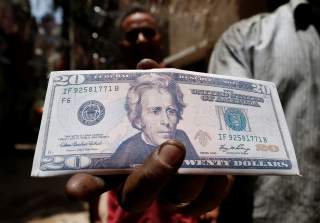Did Trump's Tweet Just Start a U.S.-China Trade War?
Who would win?
But Trump is also playing with fire. Beijing is unlikely to capitulate in negotiations at this stage and will probably choose not to participate in talks planned for September.
What Happened
U.S. President Donald Trump tweeted on Aug. 1 that the United States plans to impose a 10 percent tariff starting Sept. 1 on the remaining $300 billion in Chinese exports. He argued that China has fallen short of its pledges to increase agricultural purchases and curb fentanyl sales to the United States. Trump tried to frame the tariff move in positive terms, calling it a "small" tariff (compared with his earlier threat to impose a 25 percent tariff), and said that he looks forward to a "positive dialogue with China" after "constructive" U.S.-China trade negotiations in Shanghai earlier in the week.
Why It Matters
China's negotiating stance fundamentally shifted after U.S.-China trade talks broke down in late April over what Beijing viewed as onerous U.S. demands on enforcement and after the United States announced severe export restrictions against Huawei in mid-May. Even though Beijing agreed to a truce and further dialogue in late June when Trump met with Chinese President Xi Jinping, China's negotiating team — with the prominent participation of Commerce Minister Zhong Shan — assumed a more hard-line stance. It held out on making concessions even on low-hanging fruit, such as increasing agricultural purchases, until the United States made tangible moves beyond vague pledges to ease its export restrictions against Huawei. With little movement from either side, it's no wonder that this week's Shanghai talks ended in a stalemate.
Judging by the United States' continued, albeit moderate, economic expansion, Trump is likely calculating that he still has enough economic room to push harder on Beijing in this negotiation by hiking tariffs. Trump has also made no secret of his displeasure with the U.S. Federal Reserve for not going far enough when lowering interest rates to stimulate more robust economic growth. Given that the Fed cited prolonged trade risk as a key driver for its July 31 decision to reduce rates by a quarter-point, Trump's move to amplify that trade risk only increases the probability of further rate cuts before the end of the year.
But Trump is also playing with fire. Beijing is unlikely to capitulate in negotiations at this stage and will probably choose not to participate in talks planned for September. If China retaliates — by restricting exports of rare earth materials that are critical to the U.S. defense industry, by blacklisting certain U.S. companies under the newly established "unreliable entity list" or by issuing export controls of key tech components — Trump may be tempted to escalate tariffs in the future.
Even a 10 percent tariff, instead of the earlier threatened 25 percent, will come back to bite American consumers and affect U.S. companies such as Apple. Equity markets are predictably diving upon news of the additional tariffs. A prolonged trade war with China will further sour the investment climate, and Trump's trade wars are already sapping global economic growth. China may be prepared to stomach the economic cost of the added tariffs and wait for another opening for dialogue if and when it becomes clearer that Trump needs to de-escalate his trade wars to shore up his 2020 re-election bid. Even then, Trump will be under heavy bipartisan pressure to avoid making a superficial trade deal with China.
What We're Watching For
Will the White House pair the "stick" of additional tariffs with a "carrot" of relaxing its export ban against Huawei? The U.S. Commerce Department earlier signaled that updated guidance will be issued in the coming days about how exactly it intends to ease up on the export restrictions. If it follows through or decides to extend the current license beyond the Aug. 19 deadline, that could keep Beijing at the negotiating table.
If we don't see any tangible moves on Huawei, China could resort to more aggressive retaliatory measures, including hiking and expanding tariffs on U.S. goods, targeting U.S. companies and restricting rare earth exports critical to the U.S. tech and defense sectors. In the meantime, China has prepared measures against U.S. companies, including the newly established "unreliable list," which allows China to blacklist U.S companies that are believed to "damage" the interests of Chinese firms.
With U.S.-China trade talks back in an escalatory phase, there is no shortage of peripheral issues that the White House could use to apply additional pressure on China and further compound trade friction. These include sanctions on China if protest violence in Hong Kong compels a direct intervention by Beijing, the advancement of U.S. defense deals with Taiwan to include the F-16 arms sales and the pending human rights sanctions over China's treatment of its Uighur population.
Trump's move to escalate the trade war with China — and the associated risk to the U.S. economy — could prevent him from escalating his trade battles with other countries. One sign of this would be Trump further delaying a decision about imposing tariffs on auto imports as he continues negotiations with the European Union and Japan. Mexico has also been hoping to neutralize Trump's tariff threats by demonstrating progress in curbing migrant flows. Trump still wants Mexico to ultimately sign a safe third country agreement but could hold off on reviving the tariff threat in early September because the U.S.-China trade war is intensifying.
U.S., China: Trump's Tariff Tweets Escalate a Mammoth Trade War is republished with the permission of Stratfor Worldview, a geopolitical intelligence and advisory firm.
Image: Reuters

